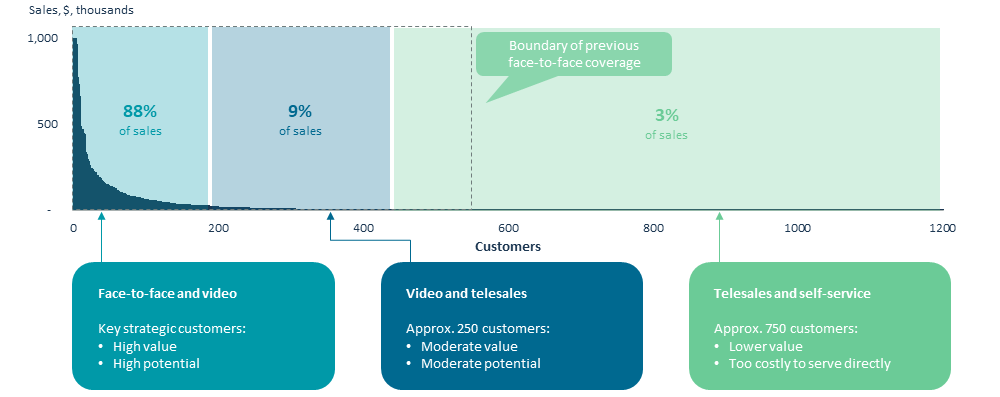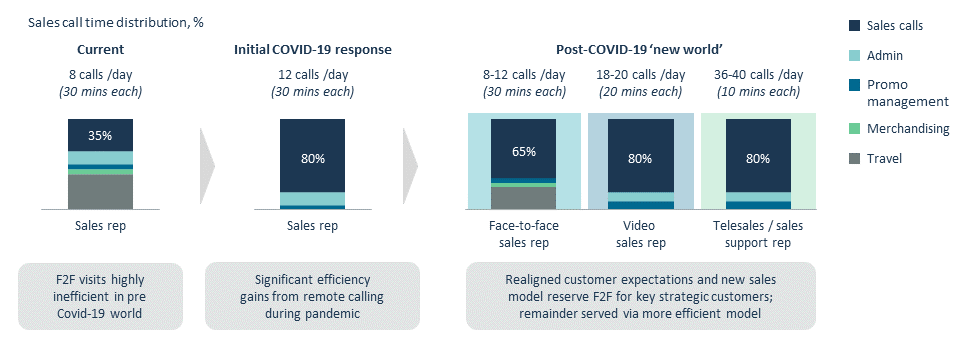Responding to sales challenges posed by COVID-19
The disruption caused by COVID-19 has changed the imperatives for near-term sales success. It will also alter the sales landscape forever. Immediately adapting route-to-market will enable sales teams to sell in the near term, while also providing opportunities to ‘road test’ alternative approaches. This will help the team learn what does (and does not) work and enable them to develop an improved sales model which can be sustained as we return to the ‘new normal.’
The current pandemic has created havoc in many businesses’ go-to-market plans, as they are often heavily reliant on face-to-face sales. Oddly, COVID-19 is a double-edged sword as it presents learning opportunities by forcing the adoption new solutions technologies – discovering that some customers can be effectively served remotely.
Customers can be migrated to a more profitable model as they become accustomed to different sales interactions over COVID-19

Source: Partners in Performance client experience – disguised
If these new approaches are effective, it could free up ~40% of a salesperson’s day which is usually spent travelling, increasing capacity and improving productivity.
In responding to the challenges posed by COVID-19, there are two main considerations – how to quickly establish an approach for the near-term and how to set the organisation up for longer term success.
1. Establish the near-term playbook
- Develop channel plans for each customer segment. This includes not only the actual ‘selling,’ but also ordering and relationship maintenance – including frequency of each. Delivery frequency and minimum order quantity will change too as businesses seek to minimise face-to-face contact – accompanied by improved enterprise economics.
- Create, refine and prioritise your prospect list. Focus salesforce capacity to target the right customers. Bear in mind that new channel plans may alter the cost-to-serve, so it may be worthwhile approaching previously unattractive customers.
- Understand the sales capacity required to serve existing customers and prospect targets. With travel out of the equation (at least for now), the time required to service existing lists will be significantly less.
- Adjust the sales force structure. With less travel and more ‘virtual’ work, sales managers will have greater capacity and fewer geographical constraints, so spans of control could be extended, and it may make sense to reconsider reporting lines.
- Establish sales ‘wiring.’ With your sales teams working remotely, it is critical to maintain alignment and accountability. Instilling the vital few KPIs, with appropriate reporting frequency and supporting meeting structures, is more important than ever to ensure your team deliver your organisation’s objectives.
- Leverage technology effectively. If face-to-face sales are simply migrated to phone or video calls, the opportunity to develop new capabilities is lost. There are many ways to interact and build rapport virtually and the current situation presents a great opportunity to learn. This could include screen sharing and presentation, scripting and promoting or joint problem solving using virtual whiteboards. It will also make it possible for Sales Managers to join and observe more calls, enabling both auditing and coaching.
- Train the team. The effectiveness of web-based sales meetings will vary greatly depending on the skill of the user, both in delivery and in ability to fully utilise the technology. It is also difficult to simply “drop in” to say hello, so your team may need to learn to book meetings.
2. Set your organisation up for long-term success
If the salesforce can work effectively virtually, and basic functions have been migrated to digital solutions, focus can shift to evaluating what is needed to thrive in the post-COVID world.
To start, ask:
- What has been learned?
- What worked well and what did not? And, why?
- Have customers successfully migrated to digital, self-service ordering? If not, why?
- Which customers truly need face-to-face meetings? And, can they be done less frequently in person (the rest virtually)? Which can be served virtually?
The learning from addressing COVID-19 can be applied to create a more effective and efficient go-forward model

Source: Partners in Performance client experience – disguised
These learnings can deliver a superior customer experience, while also improving business economics:
Re-segment your customer base. Re-evaluate the sales model and create a new customer ‘map,’ considering:
- Which customers really need, and merit, a physical sales call?
- Which customers can self-serve?
- What is the optimal sales mix in terms of visits, video calls and phone calls and, what is the right frequency?
- What are the triggers for escalation from one to the other?
Revisit sales force capacity. The new sales model will also change the delivery model, so it is important to evaluate:
- How many people are needed on the road, on screen and/or on the phone to service customers with this new segmentation?
- How does it differ from what is currently in place?
- Is there a need to retrain or reallocate roles?
- What elements of the sales force need to change to achieve the right configuration at the right cost?
Ensure ‘best-fit’ organisation structure:
- Organisation structure will probably need to adjust in the move from addressing COVID to preparing for the future. As strategic face-to-face visits are reincorporated, spans and layers will need to be adjusted to foster strong sales execution and remain economically viable.
Adjust sales ‘wiring':
- The alignment, accountability, KPIs, meetings and prioritisation needed to support the enduring sales model will differ from what was required in crisis. All layers of the ‘wiring pyramid’ must be optimised to drive the best out of the new sales organisation.
Align technology:
- In establishing your long-term operating model, it is important to ensure the right technology mix. This involves ensuring the elements of the digital sales solution fully support your business strategy and effectively integrate with the CRM.
Conclusion
Rapidly addressing sales challenges posed by COVID-19 and migrating to a new model will minimise near-term consequences of the disease. Capturing the learning to create the optimised future sales model will assist in taking a leadership position in the post-pandemic world.
Click to download a printable version of this article
About the author
.jpg?width=160&name=Bill%20Kelsall%20-%20teal%20circle%20(1).jpg)
Bill Kelsall
Director, Partners in Performance
Bill is a Director in Australia and is the Global Leader of the Sales Force Effectiveness Practice. He has over 25 years’ experience as a consultant and has served as Director of Marketing and Innovation for a major Australian FMCG company and has served on the Boards of several others.


.jpg?width=160&name=Bill%20Kelsall%20-%20teal%20circle%20(1).jpg)